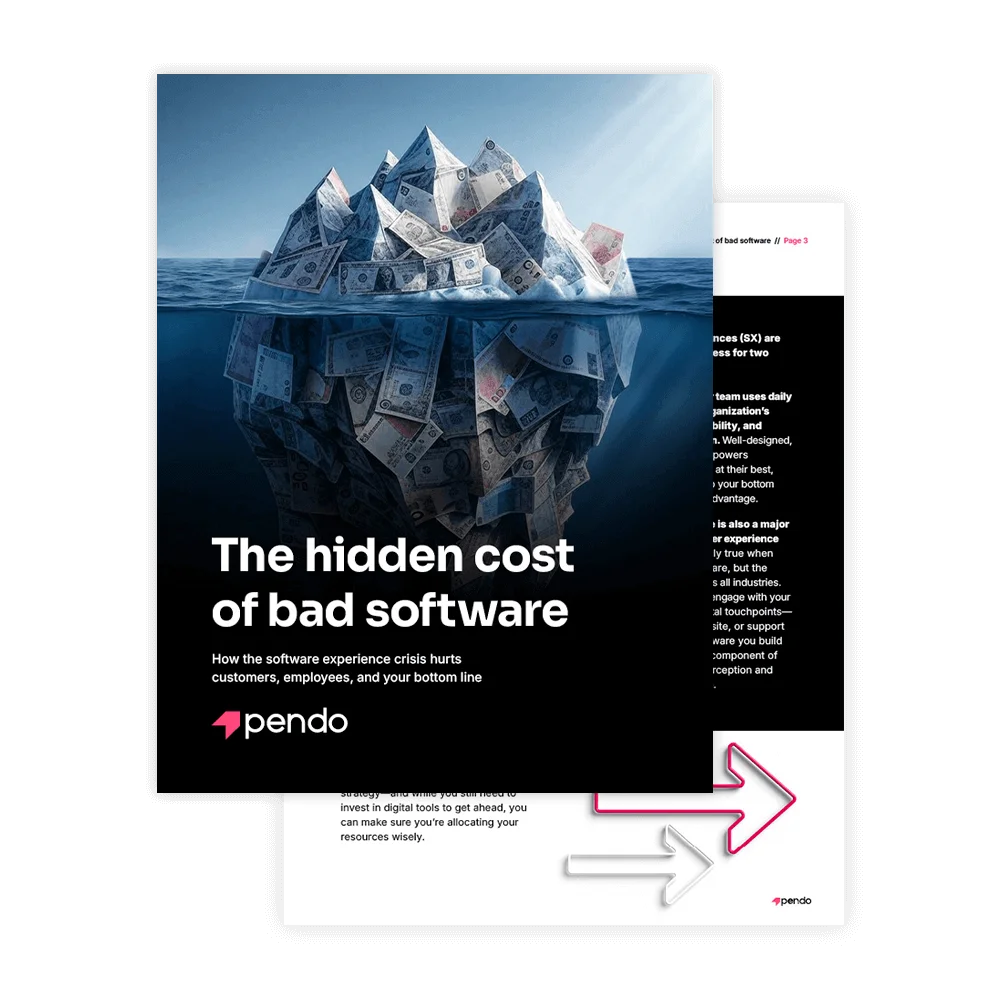
目次
In a rush? Download the PDF for later
Download the 電子書籍How the software experience crisis hurts customers, employees, and your bottom line
Forward
Imagine this: Your IT team just wasted $5 million on software that will go largely unused. Your employees are so frustrated, they’re updating their resumes. Your customers are flirting with your competitors because your development roadmap is so off-track. And worst of all, you don’t even know these problems exist yet.
While some leaders will have a harder time than others picturing this, it’s the reality—in some shape or form—at enterprises everywhere. While it may seem like these problems are caused by leadership or stiff competition, they’re actually all the result of poor software experiences.
It’s time to take charge of your software experience
Even before AI, bad software was already costing you millions in wasted productivity, R&D investments, and churn. Just because anyone can code an app in hours doesn’t mean they should.
The wrong software investments can undermine your entire business strategy—and while you still need to invest in digital tools to get ahead, you can make sure you’re allocating your resources wisely.
Good software experiences (SX) are critical for every business for two reasons:
- The applications your team uses daily are pivotal to your organization’s productivity, profitability, and customer satisfaction. Well-designed, efficient software empowers employees to perform at their best, directly contributing to your bottom line and competitive advantage.
- Software experience is also a major piece of your customer experience (CX). This is especially true when your product is software, but the impact extends across all industries. Customers inevitably engage with your company through digital touchpoints—whether an app, website, or support site—making the software you build and sell an essential component of your overall brand perception and customer satisfaction.
Software experience is an executive issue:
- 97% of IT leaders say digital experience is a strategic priority.
- CIOs can invest in employee experience by monitoring and simplifying tech stacks.
- CPOs must closely monitor software experience KPIs, like feature adoption and stickiness, to inform development roadmaps.
Executives need to take command of this issue now, starting the conversation about the impact of software experience on their companies. This challenge will only intensify as AI-powered software increases the quantity—while lowering the quality—of digital tools that employees and customers interact with daily.
To combat this in the age of AI, leaders need to adopt Software Experience Management (SXM): the practice of recognizing and treating software experience as the critical business driver that it is. This means strategically planning for good SX, measuring it, and improving it over time.
SXM will determine who rises above the rest and who drowns in a flood of tools, solutions, and platforms.
It’s time to focus on experience. It’s time to manage what matters.
Introduction: A crisis hiding in plain sight
Software spending is at an all-time high, with no slowdown in sight. In 2024, enterprises spent over $1 trillion on software, a double-digit increase from 2023.
Individual enterprises spend tens of millions annually on software to drive growth, efficiency, and innovation. However, these investments yield minimal (or no) measurable return on investment (ROI).
This problem extends across the organization: IT teams procure expensive solutions that fail to deliver expected outcomes, while product teams invest countless hours developing features that largely go unused. Pendo’s 2024 product benchmarks show that approximately 80% of built features never achieve meaningful adoption.
Meanwhile, studies show that more than half of employees feel unproductive at work, and employee disengagement and attrition are estimated to cost a median-size S&P 500 company between $288 million and $355 million a year.
Despite massive investment, employee productivity and engagement are declining. All of IT’s well-intentioned, vetted software investments are failing to deliver on their promises. At the same time, product teams waste precious development resources on features that never realize their intended value.
Bad software experience costs organizations in multiple ways:
- Misaligned product roadmap
- Lowered productivity
- Poor feature adoption
- Disengaged employees
- Wasted software spend
- Customer dissatisfaction and churn
The only way to solve this hidden crisis is through intentional, strategic software experience management.
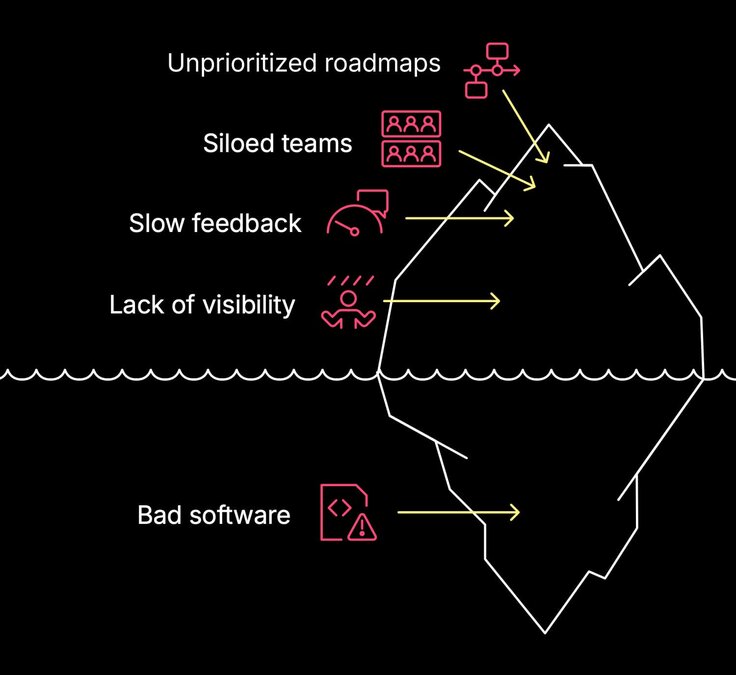
Real-world examples of the software experience crisis
It’s striking how different these examples are—from different industries, customer-facing vs. internal, user interface (UI) errors, clerical errors, and privacy violations. Yet all are attributable to bad software experience.
Audio company Sonos rolled out a redesign to their customer-facing app. Poor user experience (UX) with the redesign led to customer outrage and a projected $10-$30 million loss for the company.
Employee confusion with Citi’s internal software caused them to send a $900 million payment to a creditor instead of the intended $7.8 million. A judge ruled in favor of the creditor, which returned only $400 million of the original amount.
British Airways was fined $20 million for violating GDPR after a breach exposed 400,000 passenger records. Analysts found that the airline’s software supported enhanced security, but employees didn’t use it consistently.
Part 1: The software deluge is reaching a breaking point
According to the Department of Labor, productivity grew the most between 1947-1973 and 2001-2007. We all know what happened next: The SaaS revolution kicked off a digital transformation craze that led to rapid software creation and adoption.
However, the initial gains from digital transformation have tapered off over time. Instead of improving transparency and efficiency, end-users are dealing with overly complex tooling, siloed workflows, and disjointed information.
Still, the digital transformation train keeps rolling. New solutions promise more productivity and efficiency, and the software itself may actually be capable of supporting these claims. However, 70% of digital initiatives fail due to adoption or experience gaps.
More software doesn’t mean more revenue
Digital transformation has left us with too many apps and not enough time for onboarding and training. The answer can’t be an ever-expanding tech stack, but that’s what many organizations are headed for.
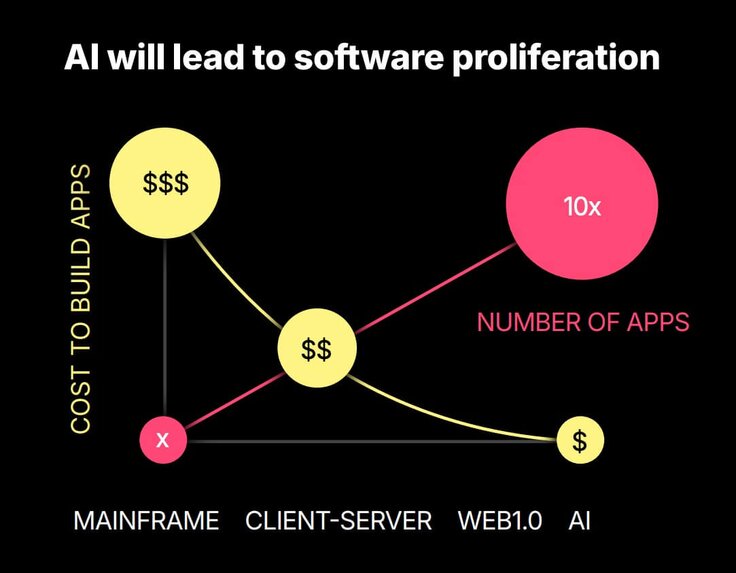
AI is accelerating the software experience crisis
AI has made “coding” more accessible to the masses. But a truly great product is so much more than code. As development becomes faster than ever, the software experience crisis will worsen thanks to the rapid adoption of no-code development tools, citizen developers, and AI copilots.
The modern enterprise’s disjointed, siloed software landscape will also make it more difficult to use AI effectively. AI agents, like chatbots and digital assistants, only work if they can access all the data sources they need. If your essential data is siloed across dozens of software solutions, it’s nearly impossible to realize the full potential of AI.
Part 2: The five horsemen of the software apocalypse
Bad software experiences may not have a line on the balance sheet, but they cost companies billions yearly. Here are five key signs your company is dealing with a software experience problem:
Horseman #1: Low adoption and R&D waste
Pendo research found that as much as 80% of a software solution’s features are rarely or never used. And it gets worse: Nearly half of all business software goes unused, wasting an eye-watering $44 million every month. Ouch.
This financial waste is due to several factors:
- Companies can’t see how users navigate the software they’ve purchased.
- Users find tools hard to navigate, leading to frustration, decreased productivity, and shadow IT.
- Users don’t have the context or information to learn and use software to its full potential.
- Users don’t adopt core features or see the value of software, leading to disengagement and churn.
Whether in IT or product management, you invest in software to deliver a return on investment. But it’s clear that right now, organizations are overspending on tech and under-delivering on results.
Horseman #2: Security threats and compliance risk
A confusing software experience can put your company’s cybersecurity and brand reputation at risk. Security threats can spring up in many different ways:
- Poor software onboarding and training, which pushes employees to seek unvetted shadow IT solutions
- Confusing user interfaces (UI) can lead to misconfigured apps, ignored features, and unused security features
- Ignored, dormant apps that become an open door for hackers over time
The recent Change Healthcare ransomware breach is a prime example of this risk. Experts believe that hackers entered Change Healthcare’s software because a remote access system had multi-factor authentication (MFA) disabled. This means a Change Healthcare end-user likely chose to turn off that security feature for a more convenient login experience—but it cost the company $22 million.
Poor software experience can also lead to compliance errors and steep fines. The cost of GDPR non-compliance starts at €10 million, or 2% of a company’s annual revenue, but regaining consumer trust may prove even more expensive.
Horseman #3: Lower productivity
The productivity cost of cluttered tech stacks and poor software experiences cannot be overstated. Research shows that 69% of workers waste a full hour every day simply navigating between applications.
This single hour of daily productivity loss compounds to six weeks per employee annually—time directly attributable to inadequate experience management and the failure to strategically optimize cross-application workflows for efficiency.
To make matters worse, nearly one-third of employees say that poor software experience was a primary driver of their decision to leave a company. Beyond the immediate productivity drain, this attrition forces companies to spend more on recruiting, hiring, and onboarding replacement talent.
More troubling still, these new employees encounter the same problematic software environment that prompted their predecessors’ departures, perpetuating a costly cycle of diminished productivity and continued turnover.
Horseman #4: Innovation stagnation and opportunity costs
Every team makes technology investments with hopes of substantial returns: Product teams want a 20x ROI, IT departments want a 200% productivity increase, and revenue teams want to exceed their forecasted ARR.
Product leaders depend on insight into the user experience to inform their roadmap, prioritize resources, and retain customers. Without behavioral insights guiding your investments—like usage analytics, customer feedback, and session replay data—prioritizing your R&D investments is a guessing game.
Remember Snap’s Augmented Reality (AR) Enterprise Service unit? The team built this to serve their biggest customers, but enterprises were slow to adopt the service. Then, less than a year after launch, the entire division was shut down. If Snap laid the proper groundwork for product discovery, this might have been avoided. In times like these, let quantitative and qualitative data be your north star.
Horseman #5: Customer churn and revenue leakage
Your customers inevitably interact with your company through digital touchpoints—whether an app or website—turning every company into a software company. The quality of your software experiences directly impacts business metrics like customer satisfaction, churn, and lifetime value (LTV).
Never underestimate the impact of your digital experiences. It’s estimated that 70% of all online purchases are abandoned due to bad UX, leading to $1.4 trillion lost globally to preventable UX-related churn.
To prevent this, leaders need to know exactly how users engage with your software, how well your development roadmap fits their needs, and how you can set users up for success.
Business leaders also need to understand how employees interact with their tech stack. Poor software experiences can lead to employee burnout, but positive software experiences improve morale and reduce turnover.
Without visibility into quantitative and qualitative product data, you won’t know why customers are leaving—or be able to identify at-risk users before they churn.
Part 3: Why companies can’t ignore software experience management
The old software development lifecycle (SDLC) was never built for the speed and scope of AI. This once-in-a-generation opportunity to change how we build software comes with major improvements—and risks.
The modern software development lifecycle is slowing us down
Whether you’re building an app for customers or modifying software for employees, the old SDLC leaves companies blind to necessary improvements. Companies need to move to the modern SDLC: an iterative process that lets you analyze your software data and then act on it.
The best way to build great software experiences is to ground development in a deep understanding of your users. From discovery and validation to post-launch optimization, you can stay closer to your users and deliver better experiences with this nine-step process:
- Plan: Define your project, business goals, and timeline.
- Discover: Analyze quantitative and qualitative data to understand your users. Then, based on user feedback and data, validate the best solution.
- Design: Translate these requirements into a development blueprint.
- Implement: Create code based on design plans.
- Test: Ensure the software you built meets performance and user requirements.
- Launch: Release your software in a staged rollout.
- Analyze: Monitor adoption, engagement, stickiness, and user sentiment.
- Act: Fix vulnerabilities, resolve friction, and close the feedback loop with relevant users.
- Improve: Continuously iterate and optimize your software.
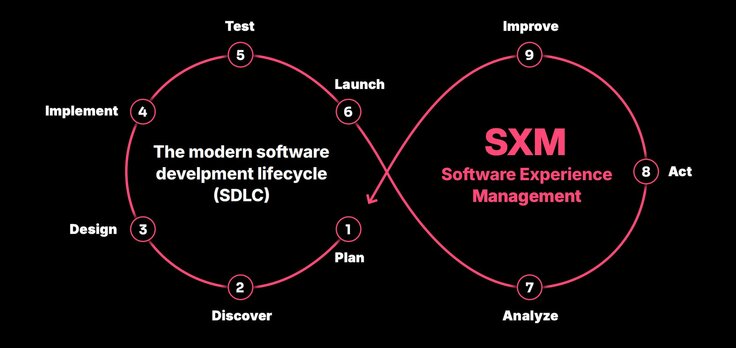
Unfortunately, existing tools make the modern SDLC impossible
To achieve this, you need to analyze and act on your data in one place. Companies are using one-off solutions to address parts of this cycle, but these make siloed data, disjointed insights, and manual re-work worse.
Right now, you’re probably using a blend of:
- Product analytics to see the software you’ve built but not what you buy and use internally.
- IT asset management (ITAM) to track licenses, but not user experiences. ITAM also doesn’t tell you if this product is driving real business outcomes.
- Voice of the customer (VOC) tools to collect opinions are not tied to in-app behaviors.
- Digital adoption tools to support and guide users in-app—but what about fixing the root problem: UX issues?
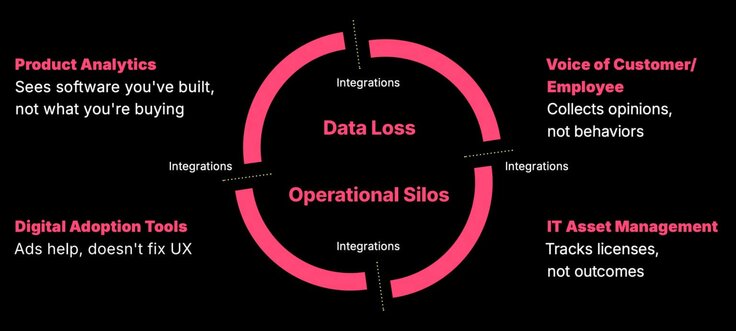
Each of these options only addresses a part of the problem, making it harder to improve software experience across the organization. If the CIO owns internal systems, the CPO owns product experiences, and the CRO owns growth, there’s no one team responsible for owning the entire software experience.
Wouldn’t it be nice if every facet of software experience lived in one place, working together? Enterprises have already “platformed” other functions to achieve this—think Salesforce for your CRM, Workday for HR Information Systems (HRIS), and ServiceNow for IT Service Management (ITSM). It’s time to platform your software experience with a Software Experience Management (SXM) solution.
What is Software Experience Management?
SXM is the practice of optimizing the experience for every software user—both employees and customers. This evolution of how you build, buy, and deploy software will ensure that every digital interaction aligns with user needs and business outcomes.
With SXM, companies can:
- Understand usage behavior by feature, user, and team
- Use AI to analyze in-app activity and surface insights
- Identify where users get stuck and guide them through workflows
- Communicate in-app to improve adoption and engagement
- Optimize R&D costs and improve return on your software investments
The anatomy of a high-performing software experience platform
With legacy solutions and silos, no one can see the full picture, and you can’t optimize what you can’t see. That’s why SXM platforms give you a unified view of the user experience across every digital touchpoint—in-app and on the web—and empower real-time iteration.
An enterprise-grade SXM platform includes:
- Product, web, mobile, and agent analytics that shed light on what users do in-app.
- Cross-channel communications tools, including in-app guides and email, to help you engage users and drive the right behaviors.
- Session replays that show you recreations of what users do—and where they get stuck.
- Feedback management tools that let you test and validate ideas, then send them to your roadmap and close the feedback loop.
- Intelligent, AI-powered insights that pull from your entire software experience.
- Portfolio optimization tools to help you quantify and optimize software spend.
Real-world examples of driving business outcomes with SXM
Companies have used the platform to achieve remarkable results:

#1: Removing in-app friction like UserTesting
When UserTesting faced challenges with their own software experience, they partnered with Pendo and found that 99% of new users abandoned the onboarding. With Pendo Analytics, they uncovered friction throughout the user journey and used In-app Guides to usher them through every step.
29%
increase in key milestone activation

#2: Reducing customer churn like HackerRank
The best time to prevent customer attrition is before warning signs emerge. That’s why HackerRank used Pendo Analytics to identify at-risk customers before traditional warning signs, and develop a customer health scoring system. With this data, HackerRank’s customer success team executed targeted, personalized outreach to low-scoring accounts and cut churn in half.
50%
reduction in at-risk customer churn
Part 4: The business impact of getting software experience right
Great software can be your company’s competitive advantage—increasing retention, saving countless support resources, and improving productivity. But how do you know if your software experience is actually good?
Investing in UX is good for business
- Every dollar invested in UX is estimated to return $100 in benefits.
- Companies that excel in design see 32% higher revenue growth.
- Better UX can drive a 25% increase in customer conversion.
- Employee experience optimization can boost productivity 5X.
The best way to measure and benchmark software experience is through quantitative and qualitative data.
Quantitative metrics that measure software experience
This category of data tells you what users do when they’re in your app. Use these as a starting point to identify patterns in user behavior, flag potential issues, and keep a pulse on day-to-day engagement.
- Monthly active user (MAU) growth: The percentage change in active users month over month. MAU growth indicates how successfully your software is attracting and maintaining users.
- Stickiness: How many users return to your software weekly or daily? This metric indicates how essential your product is to a user’s routine, and ‘good’ stickiness will vary depending on the industry and audience.
- Feature adoption: How many features in your app are generating 80% of click volume? Feature adoption tells you if users are adopting and using your product and if it’s delivering value.
- Retention: How many users continue to return to your software over a period of time? Retention—at the user or customer level—measures how successfully you’re engaging and keeping your existing user base.
- Time to value: How long does it take users to reach their ‘aha!’ moment in-app? A longer time to value means users have difficulty completing a core workflow or task.
Want to measure your quantitative data against your peers? Use Pendo’s interactive benchmarking tool.
Qualitative data tells you how users feel and why
To truly understand your software experience, you must also look at qualitative data: Why users do what they do in-app. User feedback, replays, and NPS responses can enrich SXM, especially with tools to act on what you learn. Make sure you’re monitoring:
- User feedback: How do users feel about your software? Are they requesting features or leaving comments on existing ones? Look at feedback provided to you in-app, via email, and from third-party sources. Think: Sales calls in Gong, support issues from Zendesk, and even internal email and messages.
- Session replays: This visual recreation of in-app behavior helps you see how users navigate your software and where they encounter friction.
- Net promoter score (NPS): NPS measures how likely someone is to recommend your product to others. Whether you’re gathering feedback from customers or employees, this rating system is another way to measure sentiment at specific points in their journey.
It’s time to maximize the ROI of your software
You’ve invested millions in software—but if people don’t use it, you’ll never see the value you were promised. It’s time to change how you think about software experience. Get the insights and tools you need to drive adoption, reduce waste, and improve outcomes with Pendo—the only integrated SXM platform.
Pendo: The only integrated SXM platform
Pendo gives you every tool you need for better software experiences. From SaaS and mobile to AI and agentic workflows, 14,400+ companies across 163 countries use Pendo to make their software smarter, smoother, and easier to use. Request a Demo today.
Pendo users see a 396% ROI
In 2025, Forrester conducted a TEI analysis of Pendo. The results were conclusive. Pendo delivers a large, positive return quickly to companies who invest (396%). Expect a more efficient product team, increased adoption, fewer support tickets, and time savings.

